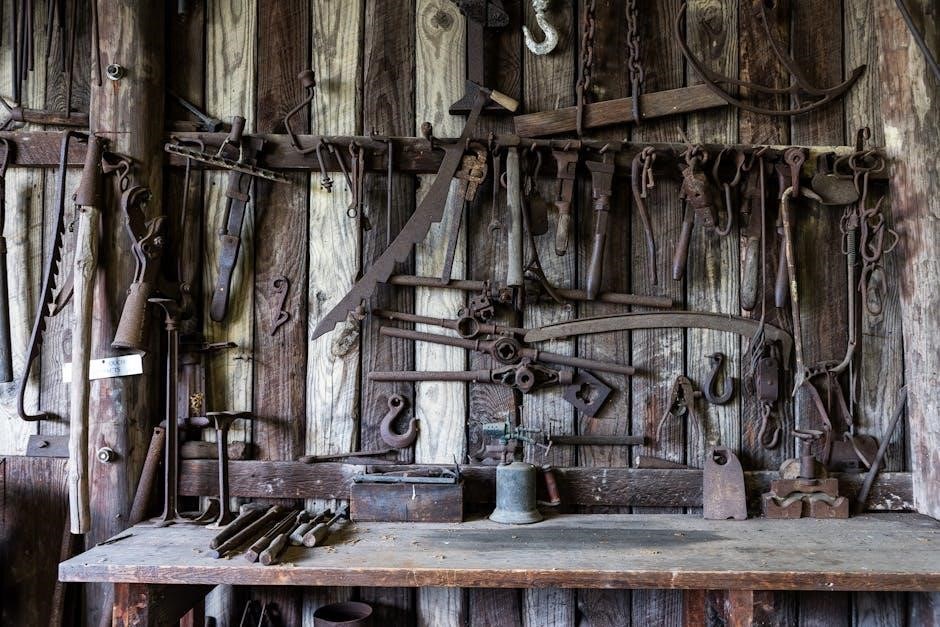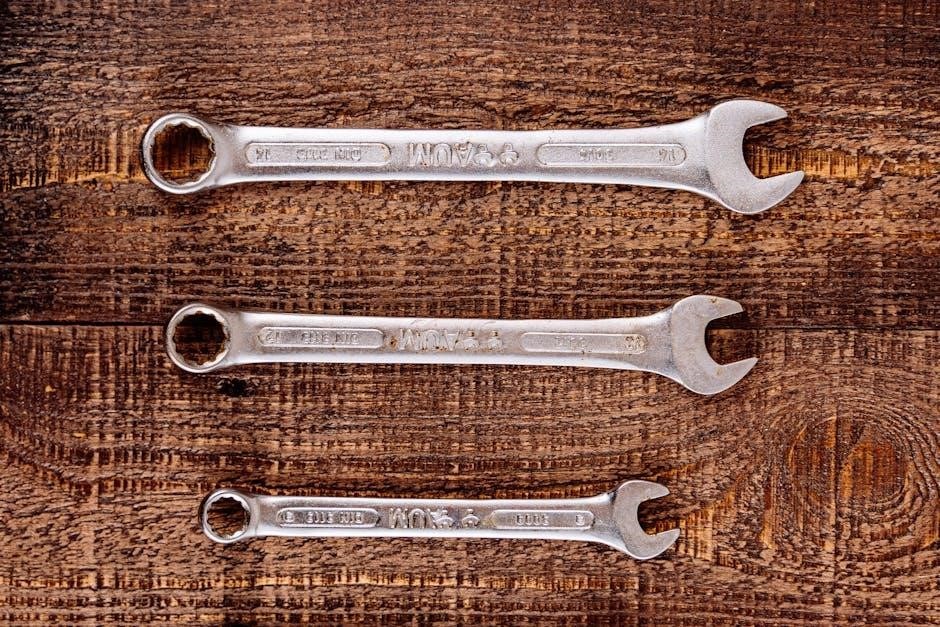A manual transmission, or gearbox, enables drivers to control gear shifts, enhancing fuel efficiency and performance. A repair manual provides essential guidance for maintenance, troubleshooting, and component replacement, ensuring optimal functionality and longevity of the transmission system.
What is a Manual Transmission?
A manual transmission, also known as a manual gearbox, is a type of transmission that requires the driver to manually change gears using a clutch pedal and a gearshift. It consists of a set of gears and shafts that transmit power from the engine to the wheels. Unlike automatic transmissions, manual transmissions rely on driver input to engage and disengage gears, offering better fuel efficiency and performance. They are popular among driving enthusiasts and are generally more durable and simpler in design compared to automatic systems. A repair manual is essential for understanding and maintaining these complex systems.
Purpose of a Repair Manual
A repair manual serves as a comprehensive guide for diagnosing, maintaining, and repairing manual transmissions. It provides detailed instructions, troubleshooting steps, and maintenance schedules to ensure optimal performance. The manual includes step-by-step procedures for disassembling and reassembling components, along with specifications for parts replacement. It is an essential resource for both professional mechanics and DIY enthusiasts, offering clear explanations and safety precautions. By following the manual, users can identify and resolve issues efficiently, ensuring the longevity and reliability of their manual transmission system. It is a vital tool for anyone working on transmission repairs.
Key Components of a Manual Transmission
A manual transmission consists of several critical components, including gears, bearings, and the clutch. The gearbox houses the gear sets, which transmit power to the driveshaft. Bearings support moving parts, ensuring smooth operation. The clutch, operated by the driver, engages and disengages the engine from the transmission. Other essential parts include the input and output shafts, synchronizers for smooth shifting, and seals to prevent fluid leaks. These components work together to enable precise control over speed and torque, making manual transmissions efficient and durable when properly maintained.
Benefits of Using a Repair Manual
A repair manual offers cost savings, empowerment through knowledge, and enhanced safety by providing clear instructions and troubleshooting tips for manual transmission maintenance and repair.

Cost-Effectiveness
Using a repair manual for manual transmission repair is highly cost-effective. It eliminates the need for expensive labor costs by enabling DIY repairs. Many manuals are available for free or at a low cost, reducing expenses. By following step-by-step instructions, you can replace parts like gaskets or seals without professional help, saving money. Regular maintenance, such as fluid checks and filter replacements, can also be done affordably. This approach ensures that you avoid unnecessary repair bills, making manual transmission upkeep more budget-friendly and sustainable in the long run.
Empowerment Through Knowledge
A repair manual empowers users by providing detailed insights into manual transmission mechanics. It equips individuals with the knowledge to diagnose and fix issues independently, fostering confidence and self-sufficiency. By understanding components like synchronizers and bearings, users can address problems effectively. The manual’s step-by-step instructions demystify complex procedures, enabling even novice mechanics to perform repairs. This knowledge not only saves money but also builds a deeper connection with the vehicle, promoting a sense of accomplishment and control over maintenance and repairs.
Enhanced Safety
A repair manual is crucial for safe manual transmission repairs. It provides detailed safety guidelines and proper procedures to follow, ensuring that each step is executed correctly. By adhering to these instructions, you can prevent accidents and ensure the transmission operates reliably. Understanding and following safety protocols is essential to avoid mechanical failures, which can lead to dangerous situations on the road. This knowledge empowers you to perform repairs confidently, knowing you’re maintaining safety and vehicle integrity.


Essential Tools and Equipment
Essential tools for manual transmission repair include basic tools like wrenches and screwdrivers, specialized tools such as gear pullers, and safety gear like gloves and goggles.
Basic Tools Needed
Basic tools for manual transmission repair include wrenches, screwdrivers, pliers, and punches. These tools are essential for disassembling and reassembling components without causing damage. Ensure all tools are in good condition to avoid rounding bolts or stripping screws. A socket set is also crucial for accessing bolts in tight spaces. Additionally, a torque wrench is necessary for proper tightening of components. These tools form the foundation of any manual transmission repair and are often highlighted in repair manuals as indispensable for successful maintenance and repairs.
Specialized Tools
Specialized tools are essential for manual transmission repair, such as bearing pullers, gear position indicators, and a hydraulic press. These tools help with precise disassembly and reassembly of complex components. A dial indicator is often used to measure gear backlash and ensure proper alignment. Additionally, a transmission jack or stand is necessary for safely handling the gearbox during repairs. These tools, while not part of a basic toolkit, are critical for professional-level repairs and are frequently recommended in repair manuals to ensure accuracy and prevent damage to components.
Safety Gear
Proper safety gear is crucial when working on manual transmission repairs. Gloves protect hands from cuts and abrasions, while safety goggles shield eyes from debris. Steel-toe boots prevent foot injuries from heavy tools or falling parts. A jack stand ensures the vehicle remains stable, and wheel chocks can prevent accidental rolling. Additionally, a well-ventilated workspace is essential, especially when handling transmission fluid; Always follow safety guidelines outlined in repair manuals to minimize risks and ensure a safe working environment. Proper safety equipment helps prevent accidents and ensures repairs are performed effectively and responsibly.
Troubleshooting Common Issues
Identifying symptoms like grinding gears or fluid leaks helps diagnose issues. Common problems include worn clutches or faulty synchronizers. Diagnostic techniques involve fluid checks and component inspections to pinpoint faults efficiently.
Identifying Symptoms
Recognizing issues early is crucial for effective manual transmission repair. Common symptoms include grinding noises during gear shifts, slipping gears, or difficulty engaging gears. Leaks in the system, unusual vibrations, or a burning smell also signal potential problems. These indicators often point to worn components like the clutch, synchronizers, or bearings. Addressing these symptoms promptly can prevent further damage and ensure the transmission operates smoothly. Regular inspections and fluid checks are essential for identifying these signs before they escalate into major repairs.
Common Problems
Manual transmissions often face issues like worn clutches, damaged synchronizers, and faulty bearings. Clutch wear can cause slipping or failure to engage gears. Synchronizers may malfunction due to excessive wear, leading to grinding during shifts. Bearings can fail from lack of lubrication or overloading, resulting in noise and vibration. Leaks in the system, such as seal or gasket damage, can cause fluid loss, reducing transmission efficiency. These problems are often diagnosed through symptoms like unusual noises, difficulty shifting, or fluid leaks, and require timely repair to prevent further damage and ensure smooth operation.
Diagnostic Techniques
Diagnosing manual transmission issues involves visual inspections, listening for unusual noises, and performing specific tests. Check for fluid leaks, worn seals, or damaged components. Test the clutch pedal for proper engagement and disengagement. Listen for grinding or whining sounds during gear shifts, which may indicate worn gears or bearings. Perform a stall test to check for slipping or hesitation. Use specialized tools like a multimeter for electronic components and refer to repair manuals for step-by-step troubleshooting guides. These techniques help identify problems accurately, ensuring effective repairs and maintaining transmission performance.

Regular Maintenance Procedures
Regular maintenance involves checking transmission fluid levels and condition, replacing filters, and inspecting components for wear or damage to ensure smooth operation and prevent issues.
Fluid Checks
Regular fluid checks are crucial for maintaining manual transmission health. Transmission fluid should be inspected every 15,000 to 30,000 miles. Check the fluid level, color, and consistency. If the fluid appears dark, gritty, or has a burnt smell, it needs replacement. Proper lubrication prevents corrosion and wear on gears and bearings. Always use the type of fluid recommended by the manufacturer. Neglecting fluid maintenance can lead to premature component failure. Refer to your repair manual for specific guidance on fluid inspection and replacement procedures to ensure optimal transmission performance and longevity.
Filter Replacement
Regular filter replacement is essential for maintaining the health of your manual transmission. The filter prevents contaminants from entering the system, ensuring clean fluid circulation. Over time, the filter can become clogged, reducing transmission performance. Replace the filter every 30,000 to 60,000 miles or as recommended by your repair manual. A dirty filter can lead to premature wear on gears and bearings. Always use a high-quality replacement filter that meets OEM specifications. Proper installation ensures optimal fluid flow and protects your transmission from damage. Consult your manual for specific instructions on filter location and replacement procedures.
Inspections
Regular inspections are crucial for identifying potential issues in your manual transmission before they escalate. Check for signs of leaks, wear on gears, and damage to bearings or seals. Inspect the clutch and pressure plate for excessive wear. Ensure all components are properly aligned and securely fastened. Look for any unusual noises or vibrations during operation. A thorough inspection can prevent costly repairs by addressing problems early. Use your repair manual as a guide to ensure all parts meet specifications. Regular inspections help maintain smooth operation and extend the lifespan of your transmission system.
Basic Repair Procedures
Basic repair procedures involve disassembling the transmission safely, inspecting components, and replacing worn parts like bearings or seals. Reassemble carefully and test functionality to ensure smooth operation.
Replacing the Clutch
Replacing the clutch is a critical procedure that involves removing the transmission and inspecting the flywheel. The clutch kit includes the clutch disc, pressure plate, and bearing. Ensure the flywheel is resurfaced or replaced if worn. Proper alignment is essential when installing the new clutch to avoid uneven wear. Use a clutch alignment tool to center the disc correctly. After installation, bleed the hydraulic system and test the clutch pedal for smooth engagement. This process requires specialized tools and careful attention to detail for optimal performance.
Rebuilding the Transmission

Rebuilding a manual transmission involves disassembling the unit to inspect and replace worn components. Specialized tools are required to remove gears, bearings, and shafts. The process includes cleaning and reassembling with new seals, gaskets, and bearings. Proper alignment and torque specifications must be followed to ensure smooth operation. Referencing a repair manual is crucial for accurate guidance. While challenging, rebuilding can be cost-effective and extend the transmission’s lifespan significantly when done correctly.
Adjusting the Gearbox
Adjusting the gearbox ensures proper gear engagement and smooth shifting. This process typically involves loosening locknuts, adjusting the bearing preload with shims or spacers, and tightening to specifications. Proper alignment and torque values are critical to avoid damage. The repair manual provides detailed steps for specific models, such as the ZF WG180, to ensure accuracy. Regular adjustments prevent wear and maintain optimal performance. Always use a torque wrench and consult the manual for precise instructions tailored to your transmission type.

Advanced Repair Techniques
Advanced techniques involve synchronizer, bearing, and gasket replacements, requiring precision tools and expertise. These procedures restore transmission performance and prevent future damage, ensuring longevity and reliability.

Synchronizer Replacement
Synchronizer replacement is a critical advanced repair technique in manual transmissions. Synchronizers ensure smooth gear transitions by equalizing speed between gears and the shaft. Over time, they can wear out, causing grinding or difficulty shifting. Replacement involves disassembling the transmission, removing the faulty synchronizer, and installing a new one. Proper alignment and lubrication are essential to prevent future issues. This procedure requires specialized tools and expertise, making it challenging but achievable with the right guidance and equipment. Regular maintenance can help extend the life of synchronizers, but replacement is inevitable when symptoms arise.
Bearing Replacement
Bearing replacement is a complex procedure in manual transmission repair, essential for maintaining smooth gear operation. Bearings, which reduce friction and support moving parts, can wear out over time, leading to noise and performance issues. Replacement involves disassembling the transmission, removing the old bearings, and pressing in new ones. Specialized tools, like bearing pullers and presses, are required. Proper alignment and lubrication are critical to ensure longevity. While challenging, this repair can be done with the right tools and expertise, often outlined in detailed repair manuals like the ZF WG98 TSC Transmission Repair Manual.
Gasket and Seal Replacement
Gasket and seal replacement is crucial for preventing leaks and maintaining transmission integrity. Over time, gaskets and seals can degrade, leading to fluid leaks and potential damage. Replacement involves disassembling the transmission, removing old gaskets, and installing new ones with a thin layer of FIPG for a secure seal. Specialized tools may be required for certain components. Proper alignment and torque specifications are essential to avoid further issues. Detailed instructions for this process can be found in repair manuals like the ZF WG98 TSC Transmission Repair Manual, ensuring a precise and effective repair.

DIY vs Professional Repair
DIY repair empowers car owners to save costs on simple fixes, while professional intervention is crucial for complex issues requiring specialized tools and expertise to avoid further damage.
When to DIY
DIY repair is ideal for simple tasks like fluid checks, filter replacements, and basic inspections. It empowers car owners to save money and gain hands-on knowledge. DIY is suitable for minor issues such as replacing the clutch or adjusting the gearbox, provided you have the right tools and follow the manual. However, complex problems like transmission rebuilding or synchronizer replacement often require professional expertise. DIY repair fosters self-reliance but should only be attempted when confident in your skills and the scope of the task. Always prioritize safety and avoid risks that could lead to further damage.
When to Seek Professional Help
Seek professional help for major repairs like transmission rebuilding, synchronizer replacement, or bearing installation. These tasks require specialized tools and expertise. If you’re unsure about the diagnosis or lack experience, a mechanic can prevent further damage. Complex issues like slipping gears or complete system overhauls are best left to professionals. DIY attempts on critical components can lead to costly mistakes. Always consult a certified technician for advanced repairs to ensure safety and proper functionality. Professional assistance is crucial when dealing with intricate manual transmission systems to avoid complications and ensure long-term reliability.
Cost Comparisons
DIY repairs using a manual transmission repair manual can save significant costs compared to professional services. Purchasing tools and parts yourself often reduces expenses by eliminating labor fees. However, complex repairs may require specialized tools, increasing initial investment. Professional shops charge higher due to labor costs, but they offer warranties and expertise. For minor fixes, DIY is cost-effective, while major overhauls may justify professional intervention. Balancing skill level, time, and budget helps determine the most economical approach for manual transmission repairs, ensuring long-term reliability and performance.
Mastering manual transmission repair empowers drivers to maintain and fix their vehicles effectively. Regular checks, timely repairs, and informed decisions ensure longevity and optimal performance of the gearbox.
A manual transmission repair manual is essential for guiding maintenance, troubleshooting, and repairs. Regular fluid checks, filter replacements, and inspections ensure smooth operation. Common issues like clutch wear and synchronizer problems can be addressed with proper tools and techniques. Understanding the difference between manual and automatic transmissions, such as fluid requirements, helps in making informed decisions. By following the manual’s instructions, drivers can enhance safety, reduce costs, and maintain optimal performance. Consistent upkeep and timely repairs extend the lifespan of the gearbox, ensuring reliable functionality over time.
Maintenance Schedule
A well-planned maintenance schedule is crucial for extending the life of a manual transmission. Regular fluid checks every 15,000 to 30,000 miles ensure proper lubrication. Transmission filters should be replaced every 30,000 to 60,000 miles to maintain cleanliness. Inspections of seals, gaskets, and bearings should occur annually or as specified in the repair manual. Consistent upkeep prevents wear and tear, reducing the risk of major repairs. Adhering to the recommended schedule ensures smooth operation, enhances performance, and avoids costly breakdowns. Always consult the manual for specific intervals tailored to your vehicle’s make and model.
Troubleshooting Tips
Identify symptoms like unusual noises, difficulty shifting, or slipping gears to diagnose issues early. Check transmission fluid levels and condition, as low or dirty fluid can cause poor performance. Inspect for worn clutch components or damaged synchronizers. Use the repair manual to guide diagnostic steps and pinpoint problems. Regularly inspect bearings and seals for wear. Addressing issues promptly prevents further damage. Always refer to the manual for specific troubleshooting procedures tailored to your transmission type. Early detection and repair can save time and money, ensuring smooth and reliable operation.
Resources for Further Learning
Explore recommended repair manuals, online forums, and instructional videos for in-depth guidance. These resources offer detailed instructions, troubleshooting tips, and expert advice to enhance your repair skills.
- Recommended manuals provide step-by-step repair guidance.
- Online forums share real-world experiences and solutions.
- Repair videos demonstrate complex procedures visually.

These tools help deepen your understanding and improve repair proficiency.
Recommended Manuals
Premium repair manuals like the ZF WG180 and WG200 offer comprehensive guides for transmission repair. These manuals include detailed diagrams, troubleshooting steps, and maintenance schedules. The Honda manual transmission repair document provides specific instructions for diagnosing and disassembling transmissions safely. Additionally, the Meritor 9/10 Speed Manual Transmission Operator’s Manual is a valuable resource for understanding transmission lubrication and preventative maintenance. These manuals are essential for both DIY enthusiasts and professionals, ensuring accurate and efficient repairs. They cover various transmission models, making them versatile tools for any repair scenario.
Online Forums
Online forums are invaluable resources for manual transmission repair. Communities like Reddit’s DIY and automotive groups offer real-world experiences and troubleshooting tips. Specialized forums for brands like ZF or Honda provide model-specific advice. These platforms allow users to share repair stories, ask questions, and gain insights from experienced mechanics and enthusiasts. They often include links to repair manuals, tutorials, and videos, making them a comprehensive support system for both beginners and professionals. Engaging with these forums can save time and money by providing solutions to common issues and rare problems alike.
Repair Videos
Repair videos are an excellent resource for visual learners, offering step-by-step guidance on manual transmission repair. Platforms like YouTube host tutorials by experienced mechanics, covering tasks such as clutch replacement and gearbox rebuilding. These videos often include close-ups and detailed explanations, making complex procedures easier to understand. Many videos are model-specific, such as those for ZF WG180 or Honda transmissions, ensuring relevance. They also provide tips for using specialized tools and troubleshooting common issues. Repair videos empower DIYers and professionals alike, bridging the gap between theoretical knowledge and practical application, and are often complemented by downloadable manuals for further reference.

